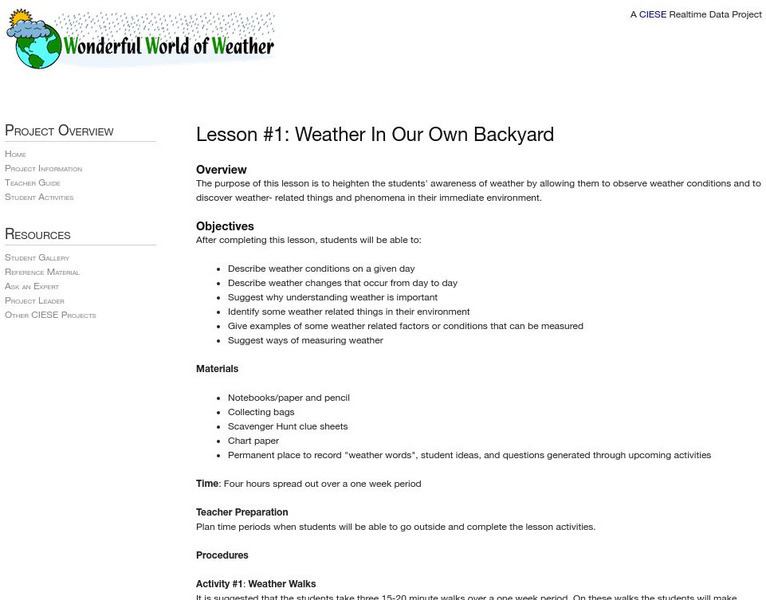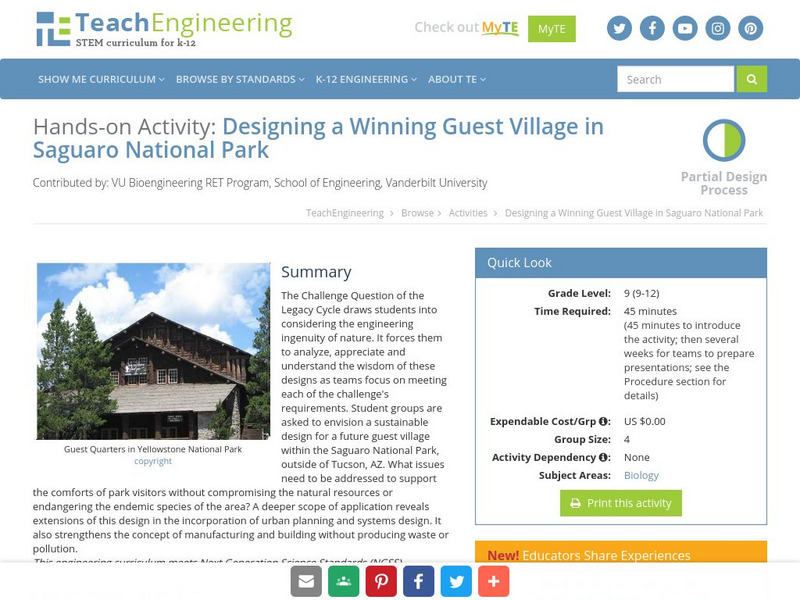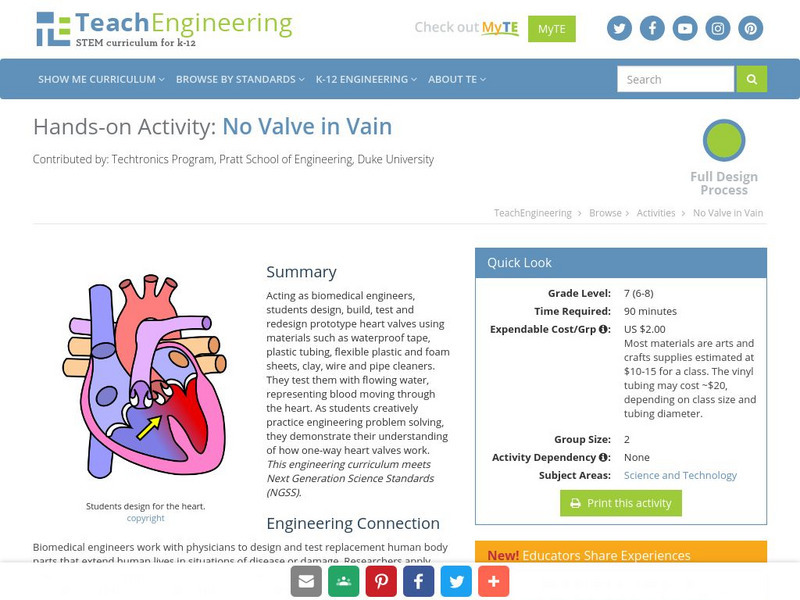Hi, what do you want to do?
Curated OER
Beginning Sounds-What sound does each picture begin with?
Students view a multimedia presentation to identify beginning sounds. In this phonics lesson plan, students recognize beginning sounds. Students navigate a website for addition phonics sounds.
Curated OER
Symmetry: Theory, Reality and Art!
Pupils explore the concept of geometric symmetry. In this geometric symmetry lesson, students walk around their school and take pictures of objects that demonstrate symmetry. Pupils use Microsoft Paint to draw the lines of symmetry on...
Curated OER
Series and Parallel Circuits
Students examine electricity. In this circuits lesson students complete an activity that shows them the configuration of circuits.
Curated OER
Measurement, Perimeter and Area
Young scholars explore the concept of measurement. In this measurement instructional activity, students collect data about themselves such as height, finger length, neck circumference, foot length, and other body...
Curated OER
Breaking News English: Moscow Subway Cars to Have CCTV
In this English worksheet, students read "Moscow Subway Cars to Have CCTV," and then respond to 47 fill in the blank, 7 short answer, 20 matching, and 8 true or false questions about the selection.
Curated OER
Introduction to Ecology
Eighth graders identify the living and nonliving components of an ecosystem. In this ecology instructional activity, 8th graders explain the role each organism plays. They participate in class discussion and answer a quiz at the end...
Curated OER
Appreciating The World By Learning About Landforms
Children can learn about the Earth's landforms and develop a greater appreciation of our world.
Georgia Department of Education
Ga Virtual Learning: Contemporary Literature: Outside Reading Made Fun
This lesson is an introduction to an "Outside Reading Made Fun" unit in which students select a book to read for pleasure, write journal questions, write an analytical essay, create a book project, and participate in a book discussion.
Other
Outside My Window
Students at Evergreeen Valley High school in San Jose, CA invite others to send them photographs taken outside their windows to promote unity and friendship around the world.
Center for Innovation in Engineering and Science Education, Stevens Institute of Technology
Ciese Real Time Data Projects: Weather in Our Own Backyard
This lesson is divided up into three activities, two of which take place outside. By the end of the lesson students will be able to describe weather conditions on a given day and some of the factors that contribute to them. Students will...
University of California
The History Project: 15th Century European Life Hours of Catherine of Cleves
During the late medieval period, the involvement of ordinary (lay) people within the church changed. Where the clergy and sacraments were the primary focus of medieval Catholicism, members of the laity increasingly incorporated...
Other
Project Wild: Wildlife Is Everywhere! [Pdf]
Teach students to be more aware of the wildlife in their surroundings, inside or outside. Includes activity, extension activities, and evaluation ideas.
Yale University
Avalon Project: Fort Laramie Treaty, 1868
Actual text of the treaty with the Sioux nation, which grants an enormous part of the Wyoming, Montana and Dakota territories to the Sioux, promises clothing and farm supplies instead of money, provides schooling, medical and other...
University of California
History Project: Women Outside the Compass 1880 1922
Lesson on women and the push toward equality in which students analyze primary source text and images to evaluate the significance of women working for equal rights.
Science Buddies
Science Buddies: Beach Bum Science: Compression of Wet Sand
Did you ever notice the cool patterns around your footprints when you take a walk in the wet sand at the beach? The pressure of your feet has effects far outside your footprints. Here's a project that uses a simple experimental apparatus...
Buck Institute
Buck Institute for Education: Pblu: Resilience Cafe
PBLU offers an example of project-based learning where students parallel tales of resilience out of historical context to those exhibiting resilience within their communities or even their own homes. This idea developed out of...
Alabama Learning Exchange
Alex: Card Table Project
Students will work in groups to design a card table. Students will communicate with each other through a class blog or class discussion page. Students will then work in groups to design a card table. After the design phase, students will...
Alabama Learning Exchange
Alex: Thinking Outside the "Box"
The students will find the area of each two dimensional figure on a net of a rectangular prism. In groups, students will cut out the net and create a rectangular prism. Groups will then discuss how to find the lateral area and the total...
Creative Science Centre
Creative Science Centre: Perhaps the Simplest Homemade Generator in the World
This very simple, but effective generator shows in a wonderfully engaging way the fundamentals of electricity generation. The generator is made from a coil of wire wound around the outside of a plastic 35mm-film can. The two coil ends...
TeachEngineering
Teach Engineering: Rooftop Gardens
Students explore whether rooftop gardens are a viable option for combating the urban heat island effect. Can rooftop gardens reduce the temperature inside and outside houses? Teams each design and construct two model buildings using foam...
TeachEngineering
Teach Engineering: Designing a Winning Guest Village in the Saguaro National Park
The Challenge Question of the Legacy Cycle draws the student into considering the engineering ingenuity of nature. It will force him to analyze, appreciate and understand the wisdom of these designs as the student team focuses on meeting...
TeachEngineering
Teach Engineering: No Valve in Vain
In this activity, students will design and create their own heart valves out of a variety of materials given to them, including: waterproof tape, plastic tubing, flexible plastic sheets, foam sheets, scissors, clay, etc. This activity...
Then Again
Then Again: Web Chron: Ignatius Loyola Founds the Jesuit Order
Brief article explaining the founding the Society of Jesus. Discusses the "vows taken by Loyola and his followers" as well as the work they did outside of the church.
EL Education
El Education: Collecting Nature's Alphabet
This book features two separate yet related projects created by kindergarten students at The College School in St. Louis, Missouri. After reading the book Discovering Nature's Alphabet, kindergarten students were inspired and asked to go...

























